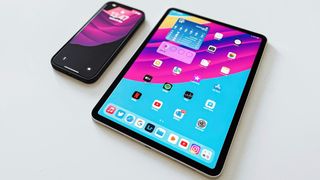The iPhone 16 could miss out on the iPad Pro’s impressive tandem OLED display – here’s why
The screen dream

Apple's big Let Loose event on May 7 delivered an iPad Pro (2024) with impressive new 'tandem OLED' display technology, which combines two panels to make one super-thin and super-bright screen. But while some commentators are speculating that this new display tech will now likely come to the iPhone 16, there are a few good reasons why that's unlikely to happen.
First, a quick primer. The iPad Pro’s tandem OLED screen – which Apple dubs the Ultra Retina XDR display – is in fact comprised of two panels. This “combines the light from both to provide phenomenal full-screen brightness,” Apple says, and allows the iPad Pro to reach up to 1,000 nits of SDR brightness (up from 600 nits in the previous model) and an incredible 1,600 nits of peak HDR brightness.
As well as that, Apple says it has enabled “sub-millisecond control over the color and luminance of each pixel,” while the iPad Pro itself has been made thinner and lighter thanks to its more advanced display.
That’s all good news – and as some commentators like Daring Fireball's John Gruber have speculated, it would seem like a no-brainer to migrate it across to the iPhone 16, right? After all, that’s Apple’s most popular device and the one where Apple loves to stuff high-end features. Yet there are a few reasons why this is unlikely to happen.
The case against

For one thing, every iPhone in the latest iPhone 15 lineup comes with an OLED panel already. Granted, it’s not a tandem stack OLED display, but it hits many of the benchmarks Apple aims for with its products.
For instance, Apple tends to set similar brightness levels for its high-end devices, with 1,000 nits of standard brightness and 1,600 nits of peak HDR brightness being achieved on the iPhone, the MacBook Pro, and now the iPad Pro. Considering the OLED-equipped iPhone has already hit that mark without the need of a tandem stack panel, Apple might not feel the need to make the switch.
As well as that, OLED panels are known to be expensive, even more so highly advanced ones like those in the new iPad Pro. If the iPhone is already reaching the brightness and quality levels Apple is aiming for without the tandem stack wizardry, will Apple want to factor in the extra cost for such a small gain? Perhaps not.
Get the best Black Friday deals direct to your inbox, plus news, reviews, and more.
Sign up to be the first to know about unmissable Black Friday deals on top tech, plus get all your favorite TechRadar content.
The latest iPhone 16 Pro display rumors, from The Elec, suggest the phone will sport ‘Multi-Lens Array" (MLA) AMOLED displays. These will still likely be the brightest screens seen on an iPhone, but without needing to include the iPad Pro's new tandem OLED tech,
That’s not to say that this tandem OLED technology won't come to any other Apple devices. There are already strong rumors that an OLED MacBook Pro is on the way, and in that device swapping out the existing mini-LED screen for an OLED replacement makes a huge amount of sense given the visual benefits it would bring, as well as the fact that it could help to make the device even thinner and lighter.
But don’t be so certain that the iPhone is next in line for this tech. Right now, the benefits might not be worth it from Apple’s point of view.
You might also like

Alex Blake has been fooling around with computers since the early 1990s, and since that time he's learned a thing or two about tech. No more than two things, though. That's all his brain can hold. As well as TechRadar, Alex writes for iMore, Digital Trends and Creative Bloq, among others. He was previously commissioning editor at MacFormat magazine. That means he mostly covers the world of Apple and its latest products, but also Windows, computer peripherals, mobile apps, and much more beyond. When not writing, you can find him hiking the English countryside and gaming on his PC.
Most Popular

